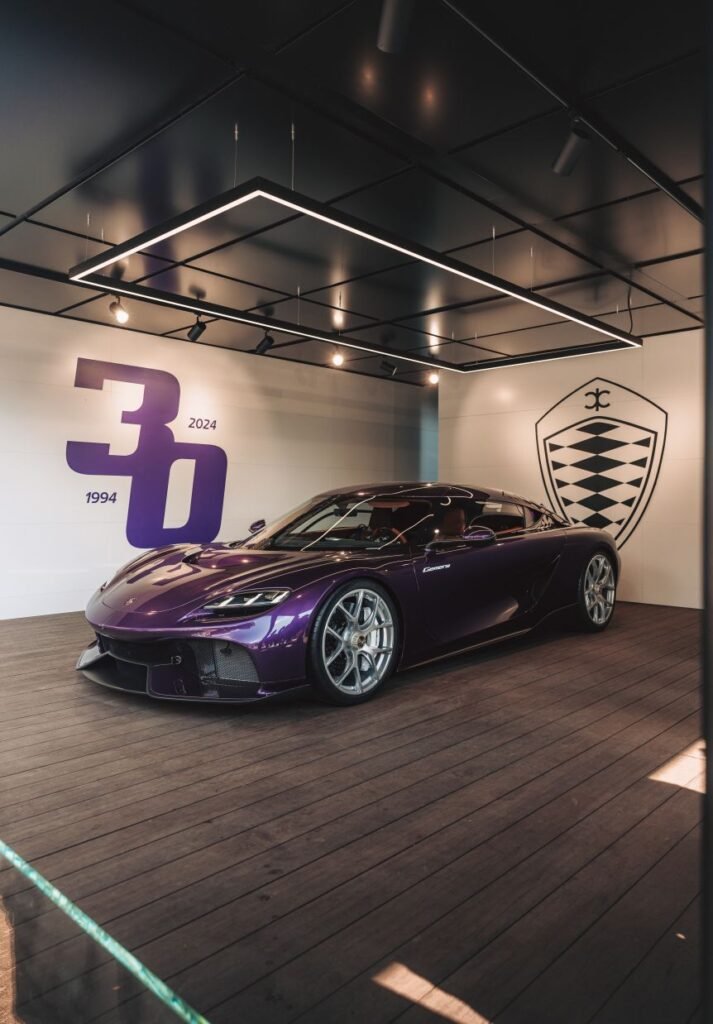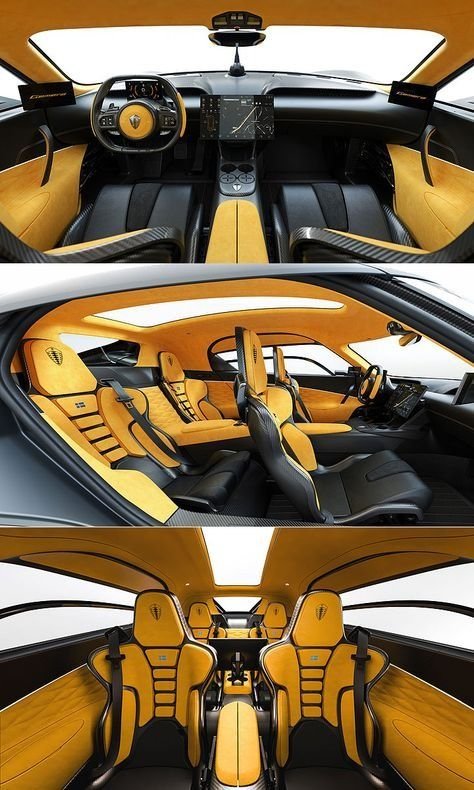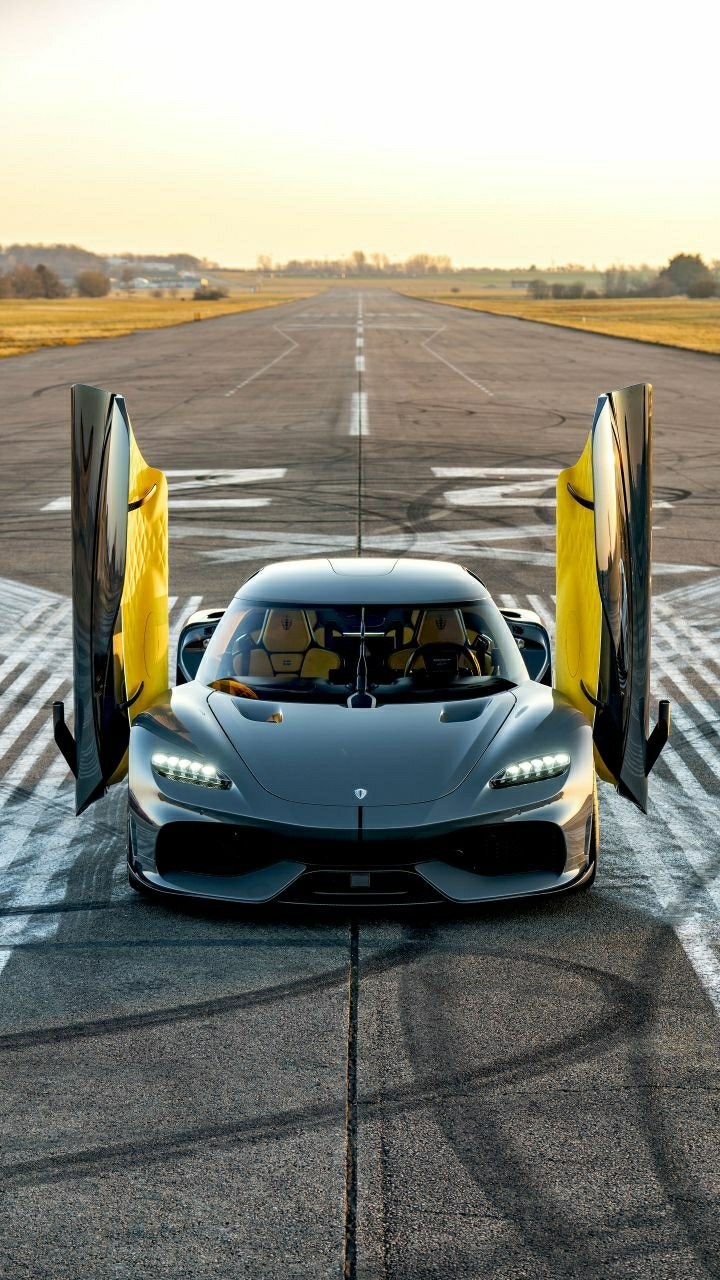The Koenigsegg Gemera marks a wild shift from the usual hypercar formula. This Swedish megacar throws down 1,700 horsepower and somehow makes room for four people, which Koenigsegg calls the world’s first “Mega-GT.”
The Gemera’s hybrid drivetrain really flips the script on high-performance vehicles. Koenigsegg proves you can blend absurd speed with something approaching family practicality.
Back in March 2020, Koenigsegg announced the Gemera as their answer to the “garage queen” problem. Most supercars barely see daylight because, honestly, they’re not useful for much beyond a Sunday blast.
This four-seat megacar aims to solve that, offering family utility without dialing down the madness people expect from Koenigsegg.
Building the Gemera wasn’t straightforward. Every bit, from the hybrid setup to the roomy interior, forced the team to get creative.
The core crew—designer Sasha Selipanov and founder Christian von Koenigsegg—put their heads together to bring this groundbreaking automotive achievement to life.
History and Inspiration
Christian von Koenigsegg wanted to break the mold with the Gemera. He didn’t just want another two-seat rocket;he wanted a four-seat “Mega-GT” that could actually do it all.
Backstory of the Gemera’s Development
Koenigsegg started developing the Gemera because the car world was changing. Even hypercar fans sometimes need a car that does more than just look good in the driveway.
The company aimed to create a car capable of performing multiple roles. It needed to deliver Koenigsegg-level performance while also accommodating four people and their belongings.
One big question kept popping up: How do you keep that sharp mid-engine feel with four seats on board?
Christian and his team spent years tweaking the design to carve out interior space without sacrificing performance. In the end, they basically invented a new type of car.
Vision and Motivation for Creation
Koenigsegg’s goal with the Gemera? Redefine what a hypercar could be. The old way—two seats, all speed, no comfort—felt a bit tired.
Christian wanted a car you could drive every day, not just on special occasions. He didn’t think people should have to pick between comfort and adrenaline.
Customers kept asking for something more versatile. They wanted the Koenigsegg experience without leaving the family behind.
That’s where the Mega-GT concept came from: blend the best of grand tourers with hypercar insanity.
Debut Event and Public Reaction
Koenigsegg pulled the wraps off the Gemera at the Geneva Motor Show in March 2020. The car world didn’t quite know what to make of it.
Four seats from Koenigsegg? People were floored. Some doubted if the brand could keep its edge with a family-friendly layout.
Media coverage went wild—some outlets loved the idea, others weren’t so sure. The press couldn’t even agree on what to call this thing.
The practical Koenigsegg kicked off a lot of debates about where hypercars go next.
Behind-the-Scenes Anecdotes
The team ran into plenty of headaches during development. Squeezing in four seats while keeping the weight balanced took some serious ingenuity.
Christian test-drove early prototypes himself. He wouldn’t sign off until it felt like a real Koenigsegg, even with the extra size.
They spent ages getting the doors right. The massive doors had to let people climb in easily but still keep the car stiff and safe.
Engineers and Christian worked side by side on the hybrid powertrain. Hitting the right mix of performance and reliability took a lot of trial and error.
Engineering Marvel: Name, Powertrain, and Performance
The Gemera tosses together a bit of Swedish language and a whole lot of hybrid tech. It brings out a wild powertrain—three-cylinder engine, electric motors, the works.
This megacar cranks out over 1,700 horsepower, helped by a trick transmission system and torque vectoring.
The Meaning Behind the Name ‘Gemera’
The name “Gemera” comes from Swedish—”ge” means “give” and “mera” means “more.”
That pretty much sums up what the car does: more performance, more comfort, more everything. It’s not just about going fast in a straight line.
Christian picked the name to highlight the car’s new approach. It’s about more than just numbers on a spec sheet.
And, yeah, it packs over a megawatt of power. That’s a lot more than most people will ever need.
V8 Engine and Three-Cylinder ‘Tiny Friendly Giant’
Under the hood, the Gemera rocks a three-cylinder engine called the Tiny Friendly Giant. This 2.0-liter twin-turbo makes 600 horsepower all by itself.
It runs on E85, sustainable fuel, or just regular gas if you’re in a pinch.
Because it’s a three-cylinder, it’s lighter than a typical V8. That frees up space for batteries and, more importantly, for people.
Koenigsegg’s Freevalve tech ditches the usual camshafts, squeezing out extra performance and efficiency.
The Tiny Friendly Giant can shut off completely when you’re just cruising on electric power. That helps stretch out the car’s all-electric driving range.
Last but not least, the Gemera sounds better than any family car ever built—take a listen for yourself
Dark Matter Electric Motor and Electric Motors
The Dark Matter electric motor is a beast—it weighs only 86 pounds but throws down 800 horsepower. It powers the front axle.
This motor kicks out 922 lb-ft of torque and spins up to 8,500 RPM. It’s surprisingly compact for what it does.
Two more electric motors drive the rear wheels. Together with Dark Matter, they give the Gemera all-wheel drive.
The electric motors hit hard right off the line. They fill in any lag while the gas engine gets its turbos going.
For daily drives, you can run just on electric. The car doesn’t need to fire up the gas engine unless you want to.
Transmission Innovations and Torque Vectoring
The Gemera uses the Light Speed Tourbillon transmission. It’s a pretty wild bit of engineering that juggles power from all the different motors and the engine.
This system lines up the three-cylinder engine and three electric motors, then sends power to all four wheels with smart torque vectoring.
Torque vectoring means the car can send more or less power to each wheel as needed. That makes it handle better, especially when you’re pushing it hard.
You can pick from different driving modes—electric, hybrid, or just full send.
The Light Speed setup skips traditional gears. It uses variable ratios to keep the power smooth and instant.
Design and Aerodynamics
The Gemera blends slick aerodynamics with luxury touches. Carbon fiber rules the exterior, while the inside feels more like a high-end lounge than a race car.
Exterior Styling and Carbon Fiber Construction
The Gemera keeps the classic Koenigsegg look—wraparound jet-fighter windshield, hidden A-pillars, and a nose that nods to the 1996 CC prototype.
Carbon fiber covers nearly every inch outside. That keeps the weight down, even with four seats.

The body stands out for a few reasons:
- Big side air intakes to keep things cool
- Short overhangs for better looks and balance
- Huge doors that swing up for easy entry
- Simple, clean lines that help it cut through the air
The design team struck a balance—aggressive enough for a hypercar, but not so wild it can’t haul the family. The carbon fiber panels keep it strong but light.
Interior Luxury and Premium Materials
Inside, you get four real seats and a load of luxury. The features list includes wireless charging and Apple CarPlay, because why not?

Comfort highlights:
- Four individual seats wrapped in premium materials
- Screens for both rows
- 4 heated and 4 cooled cup holders (seriously)
- Wireless phone charging
The 11-speaker audio system makes sure everyone hears the tunes. Onboard internet keeps everyone connected, even on long trips.
Carbon fiber details run through the cabin, tying the interior to the car’s lightweight, high-performance vibe.
Aerodynamic Solutions and Practicality
The Gemera’s shape isn’t just for show—it helps with both speed and daily usability. The clever packaging gives you space inside and still drives like a mid-engine monster.

Aero tricks include:
- Sleek bodywork to cut drag
- Integrated air intakes to keep things cool
- Flat underbody panels
- Active aero elements that change as you drive
The car can hit 249 mph thanks in part to its slippery shape. Less drag means more speed and better cooling for all those motors and the engine.
Even with all that, you still get usable luggage space. The design doesn’t force you to choose between going fast and taking a road trip.
Variants, Editions, and Engineering Team
The Koenigsegg Gemera stands out as a singular vision. Christian von Koenigsegg’s engineering team poured their collaborative genius into every detail.
They dove into new powertrain solutions and made bold packaging decisions. The project demanded expertise from all corners of automotive engineering.
Model Variants and Special Editions
The Gemera keeps things focused, sticking with just 300 cars for its entire run. Unlike other hypercar makers churning out endless variants, Koenigsegg designed the Gemera as a one-model showstopper with surprising flexibility.
Buyers can pick between two powertrains. The standard setup uses a twin-turbo V8 and electric motors for a hybrid punch.
Or, you can opt for the quirky “Tiny Friendly Giant” three-cylinder engine paired with the Dark Matter electric system. It’s a wild choice, honestly.
Key Specifications:
- Production limit: 300 units worldwide
- Primary variant: Twin-turbo V8 hybrid system
- Alternative: Three-cylinder “Tiny Friendly Giant” setup
- Electric component: Dark Matter electric motor
There’s also a convertible version coming for 2025. It sticks to the same engineering philosophy, just with more sky overhead.
Designer and Key Engineering Figures
Christian von Koenigsegg leads from the top as founder and CEO. He gets hands-on, explaining technical wizardry in his signature style whenever he talks about the car.
The team faced wild challenges making a four-seat hypercar work. They built the Light Speed Tourbillon Transmission just for the Gemera, wrapping it around the V8 to free up cabin space.
Core Engineering Achievements:
- Transmission design: Six clutches managing nine forward gears
- Packaging solution: Y-shaped drivetrain layout
- Electric integration: Seamless hybrid operation
- Weight optimization: Extensive carbon fiber construction
These folks cover everything—mechanical, electrical, aero. They managed torque vectoring without extra motors and ditched the usual reverse gear entirely.
Human Stories and Development Decisions
The Gemera started with von Koenigsegg’s vision: a hypercar that families could actually use. He wanted to prove you can have bonkers performance, four seats, and real luggage space in one car.
The engineering team had to squeeze a big V8, electric motors, and a transmission into a chassis that fit four adults. That forced them to rethink the whole drivetrain layout.
Development Challenges:
- Maintaining hypercar performance with family practicality
- Integrating hybrid systems without compromising speed
- Creating adequate interior space around powerful components
- Achieving 249 mph top speed with four-seat configuration
They ditched the starter motor, letting electric power handle startups. Reverse? All done with the electric motors—no need for extra mechanical bits.
Von Koenigsegg himself tests and tweaks every system. His engineering chops help him make tough calls as the car evolves.
Driving Experience and Market Reception
The Koenigsegg Gemera caught the eye of journalists and hypercar diehards from day one. Reviews rave about its oddball blend of hybrid muscle and real-world four-seat practicality.
Test Drives and Media Reviews
First drives show a hypercar that breaks the mold. The hybrid system glides between electric and gas power without drama.
Journalists seem wowed by the roomy interior. Four grownups fit without feeling like sardines, which is rare in this world.
The Light Speed Tourbillon transmission gets a lot of love, too. Reviewers can’t get over how it jumps between gears with no set order.
On the road, the Gemera feels more grand tourer than track monster. That’s a plus for folks who want to actually use their car.
Lap Records and Prestigious Awards
No big lap records yet—the car just hit production, so not many have had a chance to time it at famous tracks.
Koenigsegg cares more about grand touring than lap times, anyway. The Gemera aims for comfort and speed on long drives, not just track days.
The press keeps spotlighting the Gemera’s clever engineering. That hybrid system and the way they fit everything together? People notice.
Industry folks nod to the achievement of squeezing a 5.0-liter V-8 and electric motors into a four-seater. It’s a big step forward.
Competitor Mega GT and Hypercars
The Gemera doesn’t have much direct competition. Most rivals only offer two seats, so the Gemera kind of does its own thing.
Key Competitors:
- Ferrari GTC4Lusso (discontinued)
- Aston Martin DBS Superleggera
- Bentley Continental GT Speed
- Lamborghini Revuelto
Sure, cars like the McLaren P1 and LaFerrari match the Gemera for power, but they don’t do four seats or daily comfort.
With 2,300 horsepower, the Gemera outguns most of them anyway. That helps explain its eye-watering price tag.
Notable Quotes from Designers and Journalists
Christian von Koenigsegg calls the Gemera a redefinition of the hypercar. He loves that it mixes insane speed with true family practicality.
He’s said customer demand led to the V-8 replacing the original three-cylinder. That move pushed output to a wild 2,300 horsepower.
Journalists keep calling it the first practical hypercar for families. That’s not something you hear often in this space.
Technical reviewers seem genuinely impressed by the hybrid packaging and the hurdles the team cleared to make it work.
Ownership, Community, and Market Value
The Koenigsegg Gemera goes after ultra-wealthy collectors and hypercar fans who crave exclusivity and bleeding-edge tech. Only 300 will exist, and at $1.7 million, it’s deep in dream car territory.
Owner Demographic and Fanbase
Typical Gemera buyers sit at the very top of the wealth pyramid. Most already own a fleet of supercars and want the Gemera as a unique crown jewel.
Primary owner characteristics:
- Net worth exceeding $50 million
- Existing hypercar collections
- Technology and innovation enthusiasts
- Desire for exclusivity and rarity
The four-seat setup appeals to those who want to share the ride—family, friends, whoever. That’s rare in this crowd.
Koenigsegg’s got a loyal fanbase after 30 years of wild ideas and performance records. The brand attracts folks who geek out over engineering.
Collector Interest and Lifestyle Appeal
Collectors see the Gemera as a milestone. World’s first Mega-GT? That’s a big deal in car circles.
Key collector attributes:
- Limited production: Only 300 units worldwide
- First of its kind: Pioneering Mega-GT category
- Hybrid technology: Advanced powertrain innovation
- Practical luxury: Four seats with hypercar performance
The hybrid system draws in eco-minded collectors who still want to go fast. It’ll do 50km on electric alone.
Beyond speed, the Gemera piles on creature comforts—cup holders for everyone, slick tech, the works.
Pricing and Current Market Value
Base price? $1.7 million. That puts it in rarefied air with the world’s most expensive production cars.
Price positioning:
- Base price: $1.7 million USD
- Market segment: Ultra-luxury hypercars
- Competition: Bugatti Chiron, McLaren Speedtail
- Value proposition: Unique four-seat configuration
Only 300 cars means instant scarcity. Early buyers probably pay more than sticker, honestly.
Given Koenigsegg’s history, the Gemera should hold or even gain value. Their reputation for pushing boundaries helps keep resale strong.
Brand Impact and Future Legacy
The Gemera marks a turning point for Koenigsegg’s brand. It shows the company can break out of the usual hypercar mold and still lead in performance.
Brand significance:
- Market expansion: Attracts a wider luxury crowd
- Technology showcase: Highlights their hybrid powertrain chops
- Design evolution: Blends practical luxury with raw speed
- Future direction: Leans into sustainable performance
This whole Mega-GT idea might nudge the auto industry in a new direction. I wouldn’t be surprised if other brands try to follow Koenigsegg’s lead with practical, high-performance cars.
Koenigsegg’s 30-year history of record-breaking innovations puts the Gemera right up there as another big milestone. The car keeps pushing the boundaries of what’s possible, just like they always have.
Final Words
The Koenigsegg Gemera stands at the gates of automotive history for its revolutionary but not new idea of having a family car that can keep up and overtake supercars. Koenigsegg as a company is one of the boldest and most innovative car companies to ever exist. That’s because they like to challenge the status quo, and this is very evident with increasingly fast cars. While most car companies are making eco-friendly cars, Koenigsegg, even though it is using hybrid technology, is still making some of the fastest cars to ever hit our roads.
Thanks for reading! If you enjoyed this deep dive, be sure to subscribe to my email list for exclusive car reviews, insider tips, and weekly special offers on car parts, auctions, and gear — perfect for any car enthusiast.
If you have any thoughts or experiences with this car? Leave a comment below — I love hearing your opinions and sparking conversations with fellow enthusiasts.
And don’t forget to read related posts for more great content!





[…] of Tesla’s flagship sedan. It promised a jaw-dropping 520+ miles of range and mind-bending speed that would’ve shattered […]